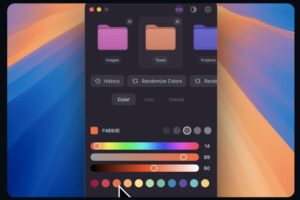Last Week on My Mac: Bring back the magic
One of the magic tricks that characterised the Mac was its association between documents and their apps. No longer did a user have to type in both the name of the app and the document they wanted it to edit. All they needed to do was double-click the document, and it magically opened in the right app.
In Classic Mac OS, that was accomplished by hidden Desktop databases and type and creator codes. For example, a text document might have the type TEXT and a creator code of ttxt. When you double-clicked on that, the Finder looked up which app had the creator code ttxt, which turned out to be the SimpleText editor, and opened that document using that app.
Although those ancient type and creator codes still live on today in modern macOS, they no longer fulfil that role. Instead, each file has what used to be a Uniform Type Indicator (UTI), now wrapped into a UTType, such as public.plain-text, normally determined by the extension to its name, .txt or .text. When you double-click on a file, LaunchServices looks up that UTType in its registry, discovers which app is set as the default to open documents of that type, then launches that app with an AppleEvent to open the document you picked.
Recognising that we often want to open a document using a different app rather than the default, the Finder’s contextual menu offers a list of suitable apps in its Open With command. That list is built and maintained by LaunchServices, and has changed in recent versions of macOS. Whereas those lists used to consist of apps installed in the traditional Application folders, LaunchServices now scours every accessible volume and folder using Spotlight’s indexes to build the biggest lists possible. If you happen to have an old copy of an app tucked away in a dusty corner, LaunchServices will find it and proudly display it alongside those in everyday use, like a game dog triumphantly presenting not one dead pheasant but every one from miles around.
For those with lean systems, this gives them the flexibility to open a large text document using BBEdit rather than TextEdit, or to select which image editor to use for a JPEG. But for those of us with lots of apps lurking in storage, the result is absurd and almost unusable. It’s bad enough working through the 33 apps that LaunchServices lists as PNG editors, but being offered 70 text editors is beyond a joke.
Unfortunately, there’s no lasting way to block unwanted apps from being added to the list LaunchServices builds for this Open With feature. You can gain temporary relief by excluding them from Spotlight search, but should you ever open the folder they’re in using the Finder, those are all added back. This also afflicts apps in folders shared with a Virtual Machine, where the list includes App Store apps that can’t even be run from within that VM.
There are, of course, alternatives. I could drag and drop the document from its Finder window towards the top of my 27-inch display to the app’s icon in the Dock at the foot, which is marginally less awkward than negotiating my way through that list of 70 apps.
But there are better solutions: why not empower me to determine which of those 70 apps should be offered in the Open With list? This is such a radical idea that it used to be possible with the lsregister command that has become progressively impotent, as LaunchServices has cast its net further in quest of more apps to flood me with. Or maybe use a little machine learning to include only those text editors I use most frequently to open documents? Apple could even brand that LaunchServices Intelligence, although that’s a little overstated.
I can’t help but think of what those magicians from forty years ago would have done, but I’m certain they wouldn’t have offered me that list of 70 apps to choose from.




